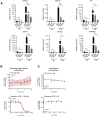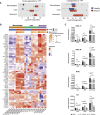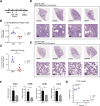TOP1 inhibition therapy protects against SARS-CoV-2-induced lethal inflammation
- PMID: 33836156
- PMCID: PMC8008343
- DOI: 10.1016/j.cell.2021.03.051
TOP1 inhibition therapy protects against SARS-CoV-2-induced lethal inflammation
Abstract
The ongoing pandemic caused by severe acute respiratory syndrome coronavirus 2 (SARS-CoV-2) is currently affecting millions of lives worldwide. Large retrospective studies indicate that an elevated level of inflammatory cytokines and pro-inflammatory factors are associated with both increased disease severity and mortality. Here, using multidimensional epigenetic, transcriptional, in vitro, and in vivo analyses, we report that topoisomerase 1 (TOP1) inhibition suppresses lethal inflammation induced by SARS-CoV-2. Therapeutic treatment with two doses of topotecan (TPT), an FDA-approved TOP1 inhibitor, suppresses infection-induced inflammation in hamsters. TPT treatment as late as 4 days post-infection reduces morbidity and rescues mortality in a transgenic mouse model. These results support the potential of TOP1 inhibition as an effective host-directed therapy against severe SARS-CoV-2 infection. TPT and its derivatives are inexpensive clinical-grade inhibitors available in most countries. Clinical trials are needed to evaluate the efficacy of repurposing TOP1 inhibitors for severe coronavirus disease 2019 (COVID-19) in humans.
Keywords: COVID-19; SARS-CoV-2; chromatin; cytokine storm; epigenetics; inducible genes; inflammation; topoisomerase; topotecan; transcription.
Copyright © 2021 Elsevier Inc. All rights reserved.
Conflict of interest statement
Declaration of interests The García-Sastre Laboratory has received research support from Pfizer, Senhwa Biosciences, 7 Hills Pharma, Pharmamar, Blade Therapuetics, Avimex, Johnson & Johnson, Dynavax, Kenall Manufacturing, and ImmunityBio. A.G.-S. has consulting agreements for the following companies involving cash and/or stock: Vivaldi Biosciences, Contrafect, 7 Hills Pharma, Avimex, Vaxalto, Accurius, and Esperovax. M.J.T. is an employee of Enhanc3D Genomics. M. Spivakov is a co-founder of Enhanc3D Genomics. I. Marazzi is an inventor in the patent WO2017106466A1
Figures











Update of
-
Topoisomerase 1 inhibition therapy protects against SARS-CoV-2-induced inflammation and death in animal models.bioRxiv [Preprint]. 2020 Dec 1:2020.12.01.404483. doi: 10.1101/2020.12.01.404483. bioRxiv. 2020. Update in: Cell. 2021 May 13;184(10):2618-2632.e17. doi: 10.1016/j.cell.2021.03.051. PMID: 33299999 Free PMC article. Updated. Preprint.
References
-
- André T., Louvet C., Maindrault-Goebel F., Couteau C., Mabro M., Lotz J.P., Gilles-Amar V., Krulik M., Carola E., Izrael V., de Gramont A. CPT-11 (irinotecan) addition to bimonthly, high-dose leucovorin and bolus and continuous-infusion 5-fluorouracil (FOLFIRI) for pretreated metastatic colorectal cancer. GERCOR. Eur. J. Cancer. 1999;35:1343–1347. - PubMed
Publication types
MeSH terms
Substances
Grants and funding
LinkOut - more resources
Full Text Sources
Other Literature Sources
Molecular Biology Databases
Research Materials
Miscellaneous

